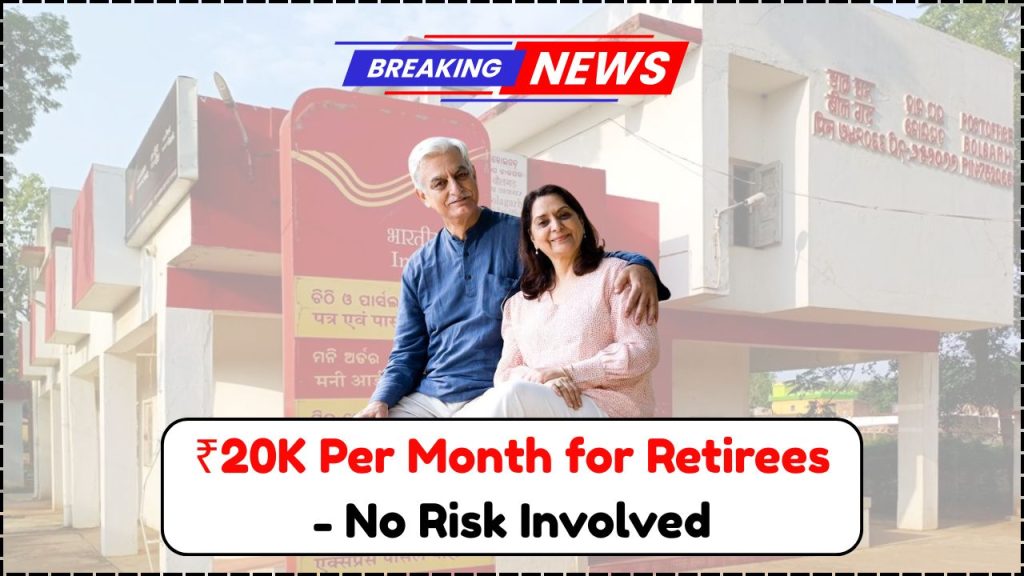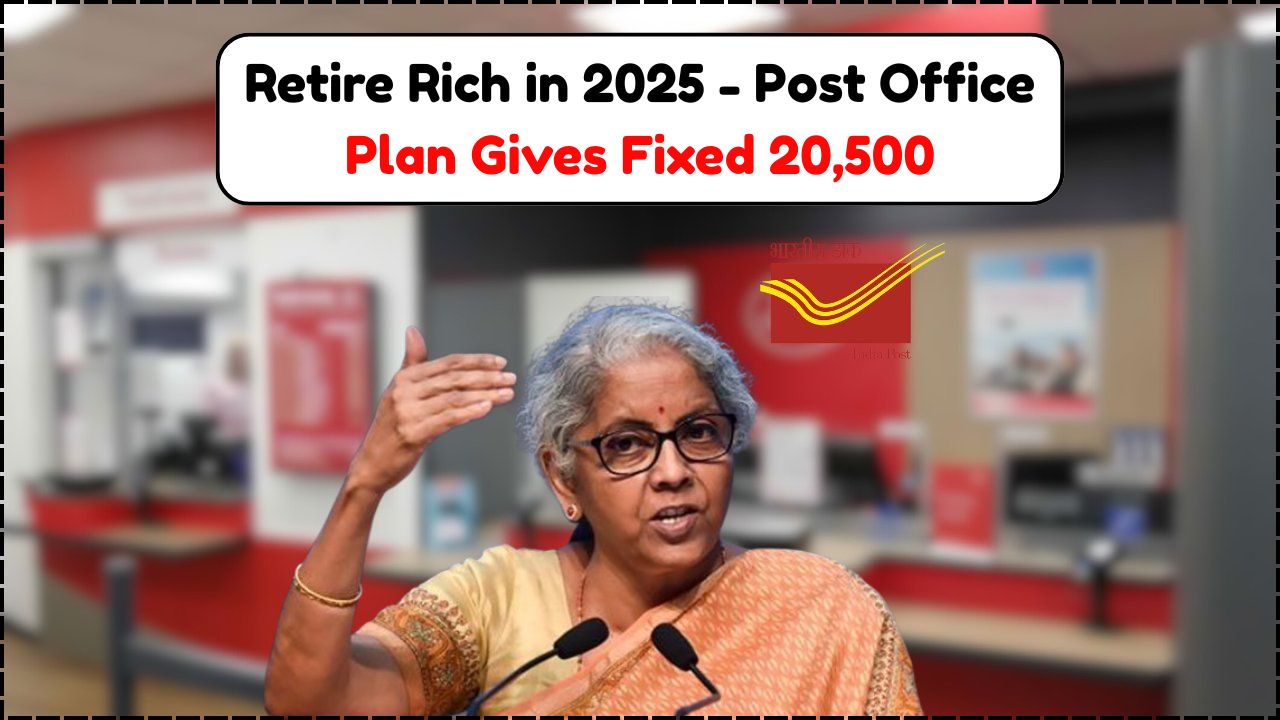
In today’s world, where inflation continues to rise and traditional savings methods struggle to keep pace with living costs, securing a reliable retirement income has become more crucial than ever. The Post Office Retirement Plan emerges as a hope for millions of Indians seeking financial stability in their golden years. This government-backed scheme promises a guaranteed monthly income of ₹20,000, offering peace of mind and financial security when needed.
Table of Contents
Understanding the Foundation of Financial Security
The Post Office Retirement Plan represents more than just another investment option, it’s a comprehensive financial safety net designed by the Indian government to address the growing concerns of post-retirement financial security. With traditional pension systems becoming less reliable and the joint family system gradually weakening, this plan fills a critical gap in retirement planning for ordinary citizens.
What makes this scheme particularly attractive is its simplicity and accessibility. Unlike complex financial products that require deep market knowledge or substantial initial investments, the Post Office Retirement Plan operates on straightforward principles that anyone can understand and benefit from. The scheme acknowledges that not everyone has access to sophisticated investment advisors or the luxury of navigating complex financial markets.
The plan’s structure reflects a deep understanding of Indian families’ financial patterns and retirement needs. By guaranteeing a fixed monthly income, it provides the predictability that retirees desperately need to plan their post-work life with confidence. This isn’t just about money—it’s about dignity, independence, and the ability to maintain one’s lifestyle without becoming a burden on family members.
How the Plan Works: Simple Yet Effective
The mechanism behind the Post Office Retirement Plan is refreshingly straightforward. Participants make regular contributions over their working years, which accumulate in a government-backed fund. Upon reaching retirement age, this accumulated amount is converted into a steady monthly payout system that ensures a consistent income flow.
The beauty of this system lies in its flexibility. Contributors can adjust their payment amounts based on their current financial capacity, making it accessible to people across different income brackets. Whether you’re a fresh graduate starting your first job or a mid-career professional looking to secure your retirement, the plan adapts to your circumstances.
The enrollment process has been deliberately simplified to encourage maximum participation. By visiting any post office across the country, individuals can begin their journey toward financial security. The widespread network of post offices ensures that even people in remote areas can access this scheme without traveling to major cities or dealing with complex banking procedures.
Comprehensive Benefits That Make a Difference
| Benefit Category | Description | Impact |
|---|---|---|
| Government Security | Full backing by Indian government | Zero risk of fund loss |
| Guaranteed Income | Fixed ₹20,000 monthly payout | Predictable retirement budget |
| Nationwide Access | Available at all post offices | Easy management and support |
| Flexible Contributions | Adjustable payment amounts | Suits various income levels |
| No Age Restrictions | Open to anyone above 18 | Early or late retirement planning |
The security aspect cannot be overstated. In an era where private pension funds can collapse and market-linked investments can lose value overnight, having government backing provides invaluable peace of mind. This security becomes even more important when you consider that retirement funds represent decades of hard work and sacrifice.
The guaranteed monthly income of ₹20,000 might seem modest to some, but its true value becomes apparent when considered as a foundation income. This amount can cover essential expenses like utilities, groceries, and basic healthcare, freeing up other savings for discretionary spending or emergencies. For many retirees, especially those from middle-income backgrounds, this guaranteed income can mean the difference between financial stress and comfortable living.
Comparing Your Options: Making an Informed Choice
| Feature | Post Office Plan | Private Pension | EPF | Mutual Funds |
|---|---|---|---|---|
| Government Backing | ✓ Yes | ✗ No | ✓ Yes | ✗ No |
| Market Risk Level | Low | Medium | Low | High |
| Monthly Payout | ₹20,000 Fixed | Variable | Variable | Variable |
| Accessibility | High | Medium | Medium | Medium |
| Contribution Flexibility | High | Medium | Low | High |
| Transparency | High | Medium | High | Medium |
When compared to other retirement options, the Post Office plan’s advantages become clear. Private pension schemes, while potentially offering higher returns, come with market risks that can erode your savings during economic downturns. The Employee Provident Fund (EPF), though government-backed, offers variable returns and may not provide the consistent monthly income that retirees need.
Mutual funds represent the high-risk, high-reward category of retirement planning. While they might generate substantial returns during good market conditions, they can also lose significant value during market crashes—a risk that becomes increasingly problematic as you approach or enter retirement.
The Post Office plan strikes an optimal balance between security and returns, making it an ideal foundation for any retirement portfolio. Smart financial planning often involves diversification, and this scheme can serve as the stable base upon which other investments can be built.
Eligibility and Getting Started
The inclusive nature of the Post Office Retirement Plan is one of its strongest features. With a minimum age requirement of just 18 years and no upper age limit, the plan welcomes everyone from young professionals to those already in their pre-retirement years. This flexibility recognizes that people start thinking about retirement at different stages of their lives.
For young adults, starting early provides the tremendous advantage of compound growth over time. Even small, regular contributions made in one’s twenties can grow into substantial retirement funds by the time they reach their sixties. For older individuals who may have neglected retirement planning, the plan offers a chance to build meaningful retirement income even with a shorter contribution period.
The documentation requirements are intentionally minimal. Valid identification and address proof are sufficient to get started, eliminating bureaucratic hurdles that often discourage people from beginning their retirement planning journey.
Maximizing Your Plan Benefits
| Strategy | Best For | Time Investment | Expected Outcome |
|---|---|---|---|
| Early Start | Young professionals | Long-term commitment | Maximum accumulation |
| Regular Reviews | All participants | Annual assessment | Optimized contributions |
| Complementary Savings | Middle-income earners | Ongoing management | Diversified portfolio |
| Professional Consultation | High-income individuals | Periodic meetings | Comprehensive planning |
Success with the Post Office Retirement Plan, like most financial instruments, depends largely on strategy and consistency. Starting early remains the most powerful approach, allowing the magic of compound growth to work in your favor. Even if you can only contribute small amounts initially, the habit of regular saving and the gradual increase in contribution amounts as your income grows can lead to impressive results.
Regular contribution reviews ensure that your retirement planning keeps pace with your changing financial circumstances. As your income increases, proportionally increasing your contributions can significantly enhance your retirement corpus without straining your current lifestyle.
Combining the Post Office plan with other financial products creates a robust retirement portfolio. While the Post Office plan provides the foundation of guaranteed income, additional savings accounts, fixed deposits, or even carefully selected mutual funds can provide the extra cushion for a more comfortable retirement.
Clearing Common Misconceptions
Many people avoid the Post Office Retirement Plan based on outdated perceptions or incomplete information. The most persistent myth suggests that government schemes are inherently inferior to private alternatives. However, the security and reliability offered by government backing often outweigh the potentially higher but uncertain returns from private schemes.
Another common misconception revolves around the adequacy of the ₹20,000 monthly payout. Critics argue this amount is insufficient for modern living costs. However, this perspective fails to consider the plan’s role as a foundation income rather than a complete retirement solution. When combined with other savings and investments, this guaranteed income significantly enhances overall retirement security.
The belief that only senior citizens should consider such plans is particularly damaging to long-term financial health. Young adults who dismiss retirement planning often find themselves scrambling to build adequate savings in their later years when time is no longer on their side.
Beyond the Basic Plan: Expanding Your Options
The Post Office network offers several complementary financial products that can enhance your overall retirement strategy. The Senior Citizens Savings Scheme provides additional income opportunities for those above 60, while various deposit schemes offer secure parking for excess funds.
Understanding these additional products allows for more sophisticated financial planning. For instance, using recurring deposits to build emergency funds while maintaining the retirement plan for long-term security creates a comprehensive financial safety net.
The key lies in viewing the Post Office Retirement Plan not as a standalone solution but as the cornerstone of a broader financial strategy that can adapt to changing needs and circumstances throughout your working life.
Frequently Asked Questions
1. What documents do I need to enroll in the plan?
A: You only need valid photo identification (like Aadhaar card) and address proof (utility bill or bank statement).
2. Can I withdraw my money before retirement age?
A: Early withdrawals are possible but come with penalties that reduce your overall returns.
3. Is the ₹20,000 monthly income subject to income tax?
A: Yes, the monthly payout is taxable under current Indian tax laws.










